Looking for fresh greens to ramp up your salads? Sunflower sprouts — technically sunflower microgreens — are easy to grow in a sunny windowsill and will be ready to eat in about a week.
Try growing popcorn shoots, too!
Sunflower sprouts are a bit chunkier than some of the other microgreens you might be familiar with. They have a bit of a nutty flavor and provide a nice, hearty crunchy texture in salads and sandwiches.
When fresh greens are hard to come by, keep several trays of microgreens in rotation. This is a great way for people who live in a small apartment to keep leafy vegetables on hand.
Ready to DIY your pantry with more wholesome ingredients? Check out my ebook, The Handcrafted Pantry! Filled with delicious recipes for some of your favorite condiments, snacks, and toppings, it’s the guide you need to start skipping packaged products and embrace homemade.The Handcrafted Pantry

Growing Edible Sunflower Seed Sprouts
There are a couple of options when it comes to finding seeds for sprouting. You can order organic sunflower microgreen seeds, packaged up specifically for sprouting, but buying sprouting seeds can get expensive.
Grow Some Greens!
Ready to grow fresh greens, no matter WHERE you live? Sign up for my
FREE quick-start guide and start growing some of your own food!
Another option is to pick up a big bag of black oil sunflower seeds — the kind people use for birdseed. That’s what I’ve used here.
Ingredients
Plastic container — Recycle from a takeout salad, a meal from the grocery store, etc.
Potting soil — Make sure you use potting soil and not topsoil, as it is made for self-contained pots/containers.
Raw sunflower seeds — No need to get fancy if you don’t want to!
How to Grow Sunflower Seed Sprouts
Fill container with about 2″ of potting soil. Make certain that the container has drainage holes to allow excess water to escape.
Scatter seeds over the soil. In this case, don’t worry about overcrowding the seeds – the wee sprouts don’t mind being crowded. You want the seeds to be in a pretty solid single layer on the soil surface.
Cover sunflower seeds with a thin layer of soil about 1″ thick. Water thoroughly and close the plastic lid, if your container has one. This helps to retain moisture until the seeds sprout.
Place out of direct sunlight, but in a sunny window, being sure to use a drainage container under the bottom of the growing tray to capture moisture.
In two or three days you’ll see little green leaves start to appear. (Left alone, these sunflower shoots would eventually grow into a sunflower plant.)
At this point, if you’re using a salad container with the lid, you’ll want to open the lid to give the growing sprouts room to grow. Watch the growing sunflower sprouts carefully and water as needed to keep the soil damp but not overly wet. Using a spray bottle to wet the soil prevents damaging the seedlings.
In another couple of days, the sunflower sprouts will be 2-3″ tall and ready to harvest. Don’t let them get much taller than that.
FAQs
How do I harvest my sunflower sprouts?
To harvest, simply use sharp scissors to snip them off at the base. The seed hulls tend to be a bit clingy, so I like to put the trimmed sprouts in a colander and rinse gently under water to remove them. Picking them off is doable but time-consuming.
How do I eat sunflower seed sprouts?
Use these sunflower sprouts as you would any other microgreens. They’re a great addition to salads, sandwiches, and wraps. They’re also great added to a fruit smoothie for a little extra nutrition!
Do I need to soak the seeds first?
I find they sprout fine without soaking, so no need to take the time for that step!
Winter Greens
You can grow microgreens year-round, but they have a special appeal during the winter months when fresh greens from the garden are a bit sparse. Other options for winter greens to consider:
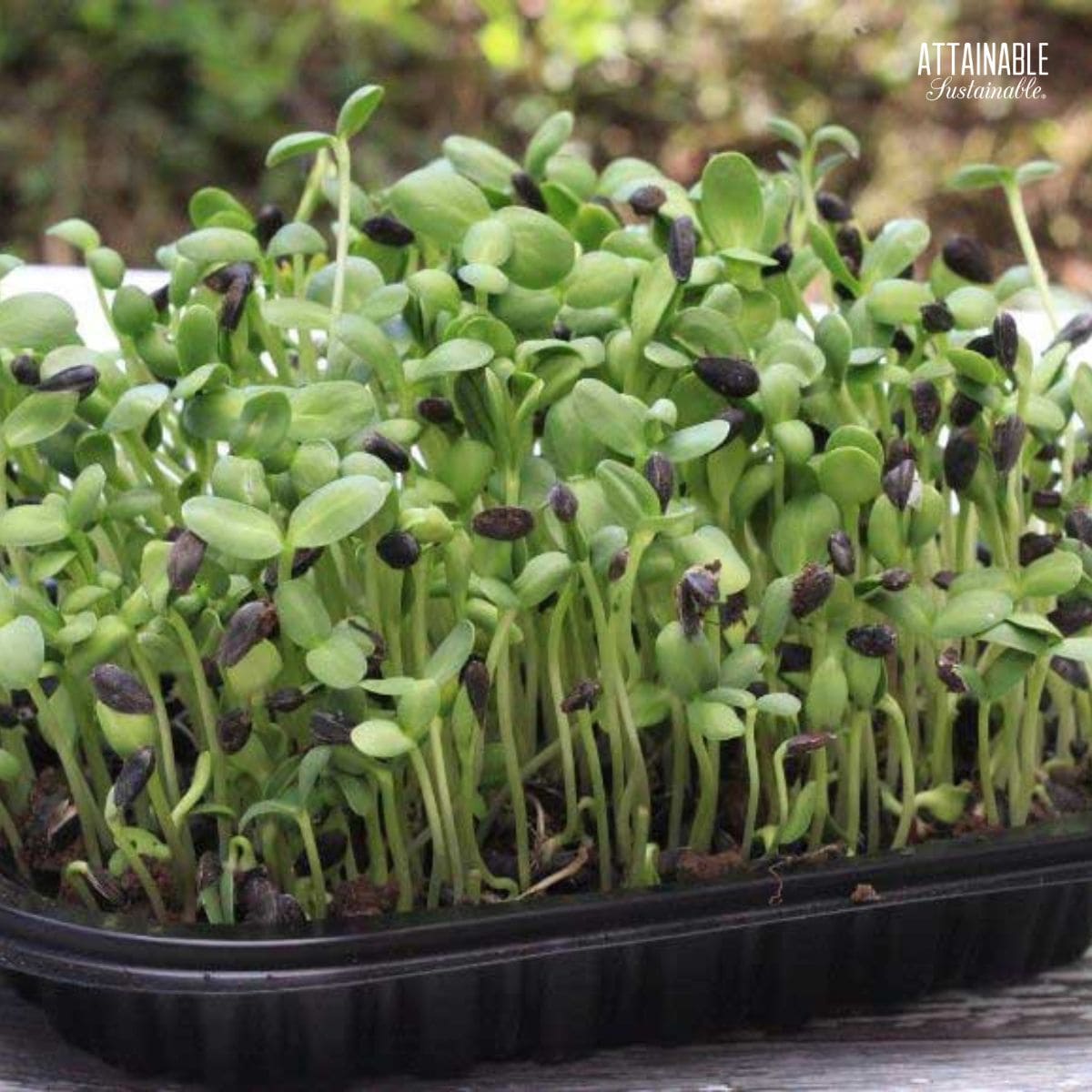
Growing Sunflower Sprouts for Crunchy Microgreens
Equipment
- drainage container
Ingredients
- a recycled plastic salad container (or similar)
- potting soil
- raw sunflower seeds
Instructions
- Fill container with about 2″ of potting soil. Make certain that the container has drainage holes to allow excess water to escape. Scatter enough seeds over the soil to nearly cover it all. Don’t worry about overcrowding the seeds – the wee sprouts don’t mind being crowded. You want the seeds to be in a pretty solid single layer on top of the soil.
- Cover sunflower seeds with a layer of potting soil about 1″ thick. Water thoroughly and close the plastic lid, if your container has one. This helps to retain moisture until the seeds sprout.
- Place in a sunny window, being sure to use a drainage container underneath it to capture moisture. In two or three days you’ll see sunflower sprouts start to appear.
- Water as needed to keep the soil damp but not overly wet.
- In another couple of days, the sunflower sprouts will be 2-3″ tall and ready to harvest. Don’t let them get much taller than that.
- To harvest, simply use scissors to snip them off at the base. The seed casings tend to be a bit clingy, so I like to put the trimmed sprouts in a colander and rinse gently under water to remove them.
Notes
- You can order organic seeds packaged up specifically for sprouting or pick up a big bag of black oil sunflower seeds — the kind people use for birdseed. That’s what I’ve used here.
- Use these sunflower sprouts as you would any other microgreen: Add to salads, sandwiches, and wraps. They’re also great added to a fruit smoothie for a little extra nutrition!
Originally published March 2020, this post has been updated.

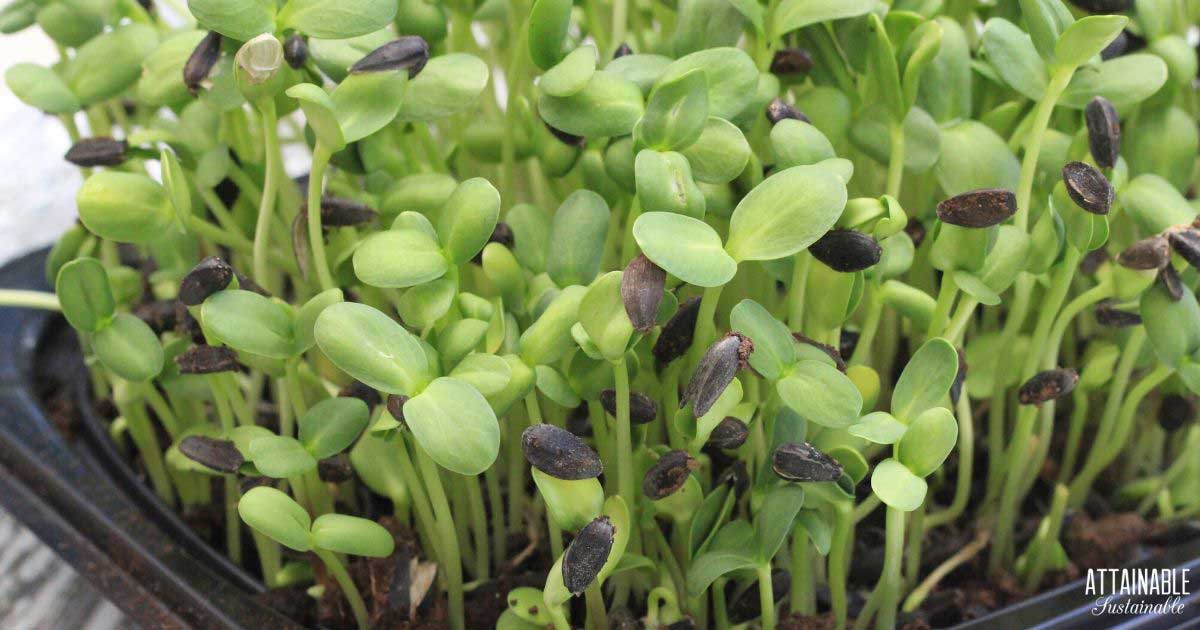
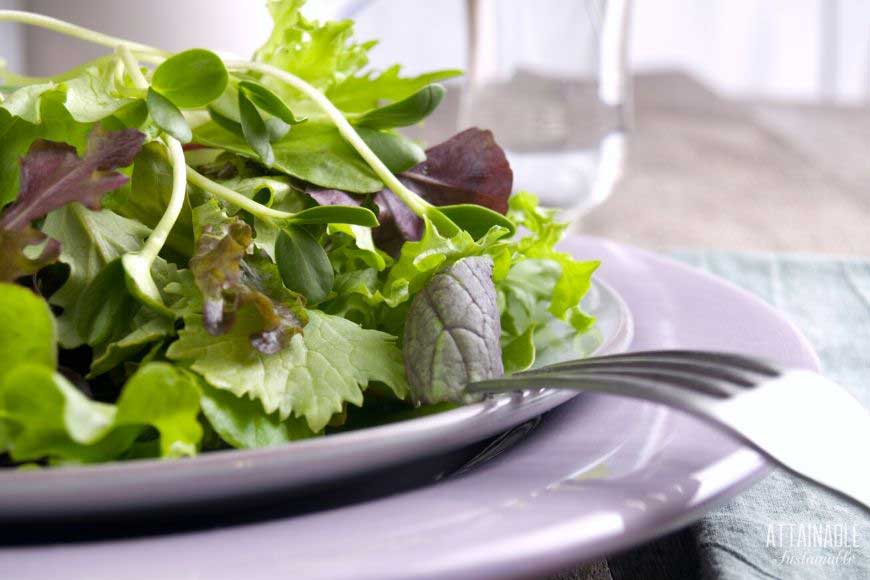
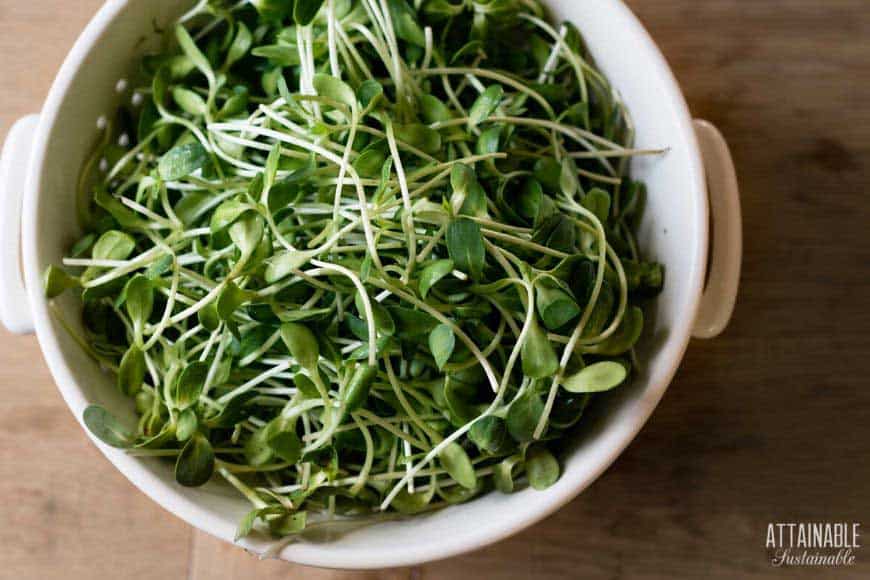
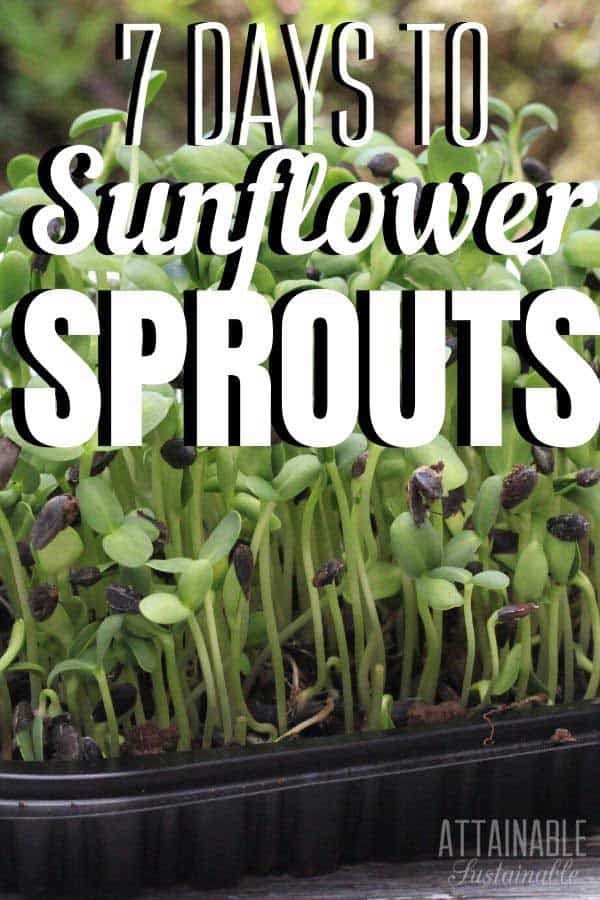
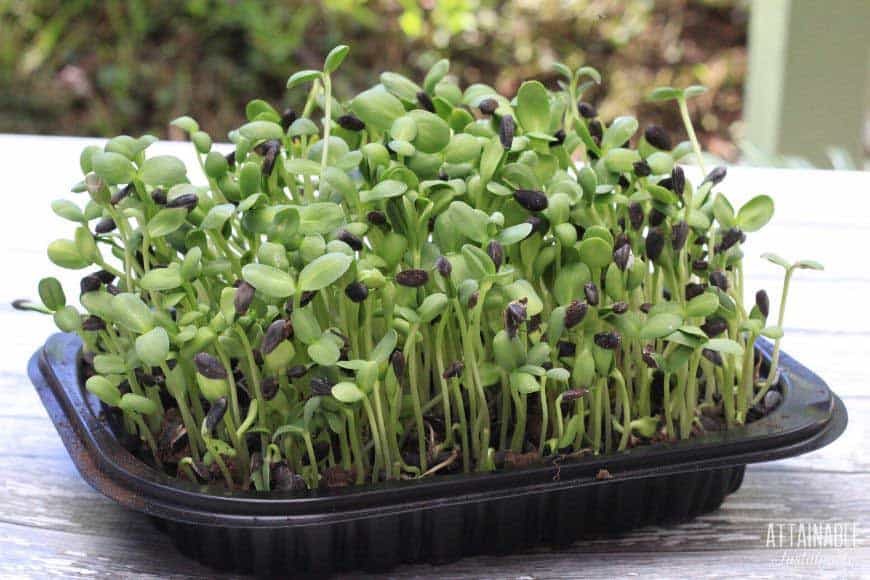

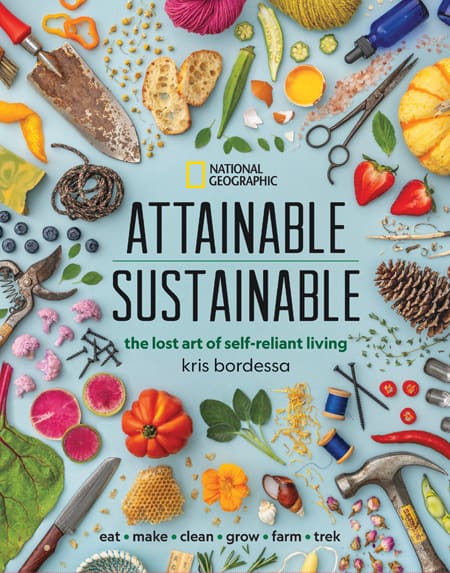
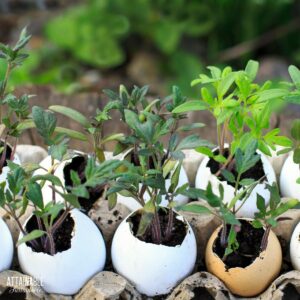
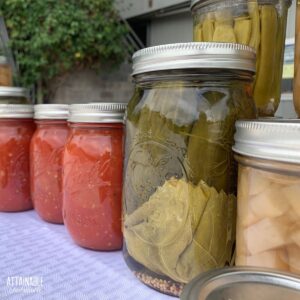

I planted a nice row of sunflowers outside 3 years ago, and have had bumper crops of volunteer plants each summer since. Can I pick and eat the sprouts coming up this spring? How do I preserve them since there are a million of them sprouting right now, and we can’t eat them all at one time?
Edible, yes. Preserving them, there’s not really a way that I know of.
Where can I get organic seeds from? Do have a simple guide chart I can follow? I’m a beginner HELP ME!
I don’t have a guide chart, but there is a link right in the post for where to buy organic seeds to sprout! 🙂
Thanks for your great posts on sprouting. Organic sunflower seed prices are indeed too high! Are you using sunflower seeds that are just the seeds or can they have their shell? I see both options as bird seed. Thank you.
The kind in the shell.
Do they sprout again after you harvest or do you completely start over? Sorry, I’m brand new to growing anything.
Goodness, don’t apologize. We all start somewhere. These are pretty much once-and-done. Add the spent soil to your compost!
I was told by a lady who had been growing microgreens that most seeds are a one-and-done but peas would grow back so you could get 2-3 harvests from those.
It can depend on the type of seed, but definitely worth a try!